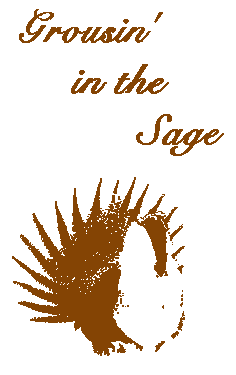






powered by SignMyGuestbook.com

| Newest
Older Previous Next Random Contact Profile Host |
blizzard warnings - 13:52 , 03 October 2013 heelerless - 21:32 , 18 August 2013 Red Coat Inn in Fort McLeod - 11:38 , 23 June 2013 rushing into the waters - 09:53 , 21 June 2013 choosing a spot - 17:43 , 27 April 2013 |
looking back and ahead
Winter, among other things, is the time of year to summarize data collected during the rest of the year.
Like hunting seasons.
So. Last fall, I checked:
169 pronghorn
137 mule deer
3 white-tailed deer
43 elk
and 1 bighorn ram, 1 sandhill crane, and 1 wild turkey.
Not to mention 1 coyote (yes, somebody took one home), 9 beaver, 4 muskrats, and 4 red fox.
Pretty sure that was the first sandhill crane I'd ever checked. Probably my first turkey, too.
No bison this year. (And by the way, the bison hunt I was planning on going along with got canceled. Hard to hunt when the hunter is in intensive care.)
The interesting data were the mule deer that I checked. Almost half the normal number, and when you look at the ones that came from south of town, where last winter was so particularly vicious, you can see the impacts of the winter on our herds.
Out of 48 bucks that I aged from the south herd, only one was over six years old. Now, old, mossy-antlered bucks are never a large proportion of the harvest, but still, normally I'd see five or six good, old bucks. But old bucks burn their fat off during the rut, early in winter, and are therefore among the first to drop if the weather gets rough.
And of those 48 bucks, only six were yearlings. In a typical year, yearling bucks would make up 40-50 percent of the harvest. Which tells us we lost an awful lot of fawns last winter.
No surprise, since most of us are estimating total loss to the deer herd at 30-50 percent. And fawns, with almost no fat reserves at all, are the first to fall.
We will continue to pay for those losses from the 2007 cohort. In three to four years we'll be missing our four and five year old bucks, the prime "big bucks" that most hunters aspire to see, if not kill. Most hunters will panic, claiming there's no "good" bucks left, and want to shut down the season. Or protect the little bucks, which makes no sense since there will probably be plenty of them.
Totally disregarding the simple fact that it takes four years to grow a four-year old buck. So, barring any surprises from Mother Nature in between, it'll take until 2012 for this year's crop of fawns to grow up to "prime".